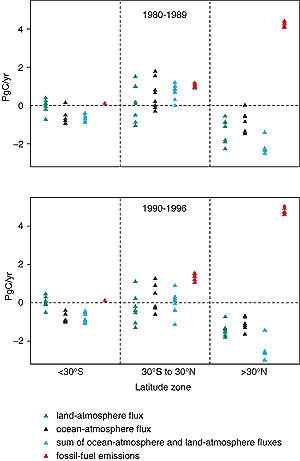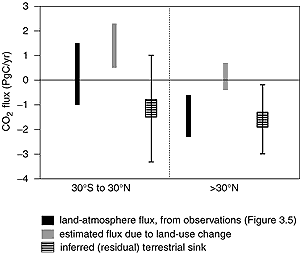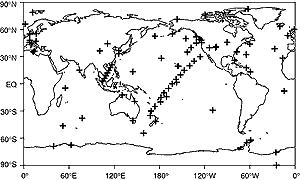3.5.3 Inverse Modelling of Carbon Sources and Sinks

Figure 3.5: Inverse model estimates of fossil fuel CO2
uptake by latitude bands according to eight models using different techniques
and sets of atmospheric observations (results summarised by Heimann, 2001).
Positive numbers denote fluxes to the atmosphere; negative numbers denote
uptake from the atmosphere. The ocean-atmosphere fluxes represent mainly
the natural carbon cycle; the land-atmosphere fluxes may be considered as
estimates of the uptake of anthropogenic CO2 by the land (with
some caveats as discussed in the text). The sum of land-atmosphere and ocean-atmosphere
fluxes is shown because it is somewhat better constrained by observations
than the separate fluxes, especially for the 1980s when the measurement
network was less extensive than it is today. The 1990s are represented by
the period 1990 to 1996 only, because when this exercise was carried out
the modelling groups did not have access to all of the necessary data for
more recent years. |
Inverse modelling attempts to resolve regional patterns
of CO2 uptake and release from observed spatial and temporal patterns
in atmospheric CO2 concentrations, sometimes also taking into consideration
O2 and/or  13C
measurements. The most robust results are for the latitudinal partitioning of
sources and sinks between northern and southern mid- to high latitudes and the
tropics. The observed annual mean latitudinal gradient of atmospheric CO2
concentration during the last 20 years is relatively large (about 3 to 4 ppm)
compared with current measurement accuracy. It is however not as large as would
be predicted from the geographical distribution of fossil fuel burning a fact that suggests the existence of a northern sink for CO2, as
already recognised a decade ago (Keeling et al., 1989; Tans et al., 1990; Enting
and Mansbridge, 1991). 13C
measurements. The most robust results are for the latitudinal partitioning of
sources and sinks between northern and southern mid- to high latitudes and the
tropics. The observed annual mean latitudinal gradient of atmospheric CO2
concentration during the last 20 years is relatively large (about 3 to 4 ppm)
compared with current measurement accuracy. It is however not as large as would
be predicted from the geographical distribution of fossil fuel burning a fact that suggests the existence of a northern sink for CO2, as
already recognised a decade ago (Keeling et al., 1989; Tans et al., 1990; Enting
and Mansbridge, 1991).
The nature of this sink, however, cannot be determined from atmospheric CO2
concentration measurements alone. It might reflect, at least in part, a natural
source-sink pattern of oceanic CO2 fluxes (Keeling et al., 1989; Broecker and
Peng, 1992). This view is supported by the early atmospheric CO2
data from the 1960s (Bolin and Keeling, 1963) which do not show a clear latitudinal
gradient, despite the fact that at that time the fossil emissions were already
at least half as large as in the 1990s. Quantitative analysis shows that the
Northern Hemisphere sink has not changed much in magnitude since the 1960s (Keeling
et al., 1989; Fan et al., 1999). On the other hand, the existing air-sea flux
measurements do not support the idea of a large oceanic uptake of CO2
in the Northern Hemisphere (Tans et al., 1990; Takahashi, 1999). An alternative
view, therefore, locates a significant fraction of this Northern Hemisphere
sink on land. This view is corroborated, at least for the 1990s, by analyses
of the concurrent latitudinal gradients of  13C
(Ciais et al., 1995a,b) and O2 (Keeling et al., 1996b). 13C
(Ciais et al., 1995a,b) and O2 (Keeling et al., 1996b).
Results of analyses for the 1980s and 1990 to 1996, carried out by eight modelling
groups using different atmospheric transport models, observational data, constraints
and mathematical procedures, are summarised in Figure 3.5. Only the most robust
findings, i.e., estimates of the mean carbon balance for three latitude bands
averaged over the two time periods, are shown. The latitude bands are: “southern
extratropics” (>30°S), “tropics” (30°S to 30°N)
and “northern extratropics” (>30°N). The carbon balance estimates
are broken down into land and ocean compartments within each latitude band (Heimann,
2001).
Although the ranges of the estimates in Figure 3.5 limit
the precision of any inference from these analyses, some clear features emerge.
The inferred ocean uptake pattern shows the sum of two components: the natural
carbon cycle in which CO2 is outgassed in the tropics and taken up
in the extratropics, and the perturbation uptake of anthropogenic CO2.
Separation of these two components cannot be achieved from atmospheric measurements
alone.
The estimates for the land, on the other hand, in principle indicate the locations
of terrestrial anthropogenic CO2 uptake (albeit with caveats listed
below). For 1980 to 1989, the inverse-model estimates of the land-atmosphere
flux are -2.3 to -0.6 PgC/yr in the northern extratropics and -1.0 to +1.5 PgC/yr
in the tropics. These estimates imply that anthropogenic CO2 was
taken up both in the northern extratropics and in the tropics (balancing deforestation),
as illustrated in Figure 3.6. The estimated land-atmosphere
flux in the southern extratropics is estimated as close to zero, which is expected
given the small land area involved. Estimates of CO2 fluxes for the
period 1990 to 1996 show a general resemblance to those for the 1980s. For 1990
to 1996, the inverse-model estimates of the land-atmosphere flux are -1.8 to
-0.7 PgC/yr in the northern extratropics and -1.3 to +1.1 PgC/yr in the tropics.
These results suggest a tendency towards a reduced land-atmosphere flux in the
tropics, compared to the 1980s. Such a trend could be produced by reduced deforestation,
increased CO2 uptake or a combination of these.
Inverse modelling studies usually attempt greater spatial resolution of sources
and sinks than is presented in this section. However, there are large unresolved
differences in longitudinal patterns obtained by inverse modelling, especially
in the northern hemisphere and in the tropics (Enting et al., 1995, Law et al.,
1996; Fan et al., 1998; Rayner et al., 1999a; Bousquet et al., 1999; Kaminski
et al., 1999). These differences may be traced to different approaches and several
difficulties in inverse modelling of atmospheric CO2 (Heimann and
Kaminski, 1999):
- The longitudinal variations in CO2 concentration reflecting net
surface sources and sinks are on annual average typically <1 ppm. Resolution
of such a small signal (against a background of seasonal variations up to
15 ppm in the Northern Hemisphere) requires high quality atmospheric measurements,
measurement protocols and calibration procedures within and between monitoring
networks (Keeling et al., 1989; Conway et al., 1994).
- Inverse modelling results depend on the properties of the atmospheric transport
models used. The north-south transport of the models can be checked by comparing
simulations of the relatively well-known inert anthropogenic tracer SF6
with measured atmospheric concentrations of this tracer, as recently investigated
in the TRANSCOM intercomparison project (Denning et al., 1999). Unfortunately
there is no currently measured tracer that can be used to evaluate the models’
representation of longitudinal transport. Furthermore, the strong seasonality
of the terrestrial CO2 flux in the Northern Hemisphere together
with covarying seasonal variations in atmospheric transport may induce significant
mean annual gradients in concentration which do not reflect net annual sources
and sinks, but which nevertheless have to be modelled correctly if inverse
model calculations are to be reliable (Bolin and Keeling, 1963; Heimann et
al., 1986; Keeling et al., 1989; Denning et al., 1995; Law et al., 1996).
Even the sign of this so-called “rectifier effect” is uncertain.
Some scientists believe that it may be responsible for a part of the apparent
Northern Hemisphere uptake of CO2 implied by inverse modelling
results (Taylor, 1989; Taylor and Orr, 2000).
- The spatial partitioning of CO2 uptake could also be distorted
by a few tenths of 1 PgC/yr because the atmospheric concentration gradients
also reflect the natural fluxes induced by weathering, transport of carbon
by rivers and subsequent outgassing from the ocean (see Figure
3.1) (Sarmiento and Sundquist, 1992; Aumont et al., 2001b). Furthermore,
the effects of atmospheric transport of carbon released as CO and CH4
(especially from incomplete fossil fuel burning, tropical biomass burning,
and CH4 from tropical wetlands) with subsequent oxidation to CO2
is generally neglected. Their inclusion in the inversion leads to corrections
of the latitudinal partitioning of up to 0.1 PgC/yr (Enting and Mansbridge,
1991).
- The distribution of atmospheric CO2 measurement stations (Figure
3.7) is uneven, and severely underrepresents the continents. This underrepresentation
is due in part to the problem of finding continental locations where measurements
will not be overwhelmed by local sources and sinks.
- Because of the finite number of monitoring stations, the mathematical inversion
problem is highly underdetermined. In principle a multitude of different surface
source/sink configurations are compatible with the atmospheric data, within
their measurement accuracy. Therefore, in order to extract a meaningful solution,
additional information on the sources and sinks has to be introduced into
the calculation. Examples of this additional information include maps of air-sea
fluxes from observations or ocean models, patterns of terrestrial CO2
exchanges inferred by terrestrial models, and remote sensing data. Thus, many
methodological choices about the use of auxiliary data can influence the outcome
of the analysis.
Interannual variability of climate is likely to strongly influence the spatial
distribution of CO2 sources and sinks, so that analyses based on
a few years of data are insufficient to establish a long-term trend.
In conclusion, the present atmospheric measurement network, current information
on air-sea fluxes and current understanding of vertical atmospheric transport
are not sufficient to allow full use of the potential of inverse modelling techniques
to infer geographically detailed source-sink distributions of anthropogenic
CO2.

Figure 3.6: Partitioning the 1980s land-atmosphere flux for
the tropics and the northern extratropics. The residual terrestrial
sink in different latitude bands can be inferred by subtracting the
land-use change flux for the 1980s (estimated by modelling studies:
Houghton, 1999; Houghton and Hackler, 1999; Houghton et al., 2000;
McGuire et al., 2001) from the net land-atmosphere flux as obtained
from atmospheric observations by inverse modelling for the same period
(Heimann, 2001; results from Figure 3.5). Positive
numbers denote fluxes to the atmosphere; negative numbers denote uptake
from the atmosphere. This calculation is analogous to the global budget
calculation in Table 3.1, but now the
model results are broken down geographically and the land-atmosphere
fluxes are obtained by inverse modelling. The upper and lower bounds
on the residual sink are obtained by pairing opposite extremes of
the ranges of values accepted for the two terms in this calculation
(for example, by subtracting the bottom of the range of values for
land-use change with the top of the range for the land-atmosphere
flux). The mid-ranges are obtained by combining similar extremes (for
example, subtracting the bottom of the range for land-use change emissions
from the bottom of the range land-atmosphere flux). |
|

Figure 3.7: The atmospheric CO2 measuring station
network as represented by GLOBAL VIEW CO2 (Comparative
Atmosphere Data Integration Project -Carbon Dioxide, NOAA/CMDL, http://www.cmdl.noaa.gov/ccg/co2). |
|
|